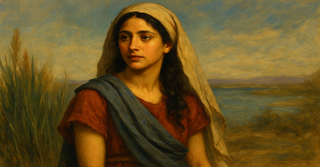What Does the Bible Tell Us about Miriam, the Sister of Moses?
Share

In the Bible, Miriam was the older sister of Moses and Aaron and an important figure in the Hebrew exodus from Egypt. Today, Miriam is seen as one of many remarkable women of faith, whose story is recorded in the pages of Scripture.
What Do We Know About Miriam’s Family and Early Life?
Miriam is first introduced in the early chapters of Exodus, where she is first mentioned as the eldest daughter of Amram and Jochebed (Exodus 2:4), Hebrew slaves and descendants of the house of Levi (see Exodus 2:1; Numbers 6:20; and Numbers 26:59).
For historical context, Levi was the third son of Jacob (Genesis 29:34), the son of Isaac and the grandson of Abraham. Centuries prior to the Hebrew exodus from Egypt, God had renamed Jacob to “Israel” (Genesis 32:28; Genesis 35:10) and promised that Jacob would, like his grandfather, become the father of many nations (see Genesis 12).
Near the end of his life, Jacob took his sons, Levi among them, and moved his family to Egypt to sojourn in the land of Goshen during a time of famine (Genesis 46-50). Here, the descendants of Israel multiplied and even thrived (see Exodus 1:7).
However, when a new pharaoh, who did not know of Israel’s prior contributions to the land of Egypt or remember Egypt’s relationship with the children of Israel, came to power, the Egyptians began to fear the growing population and threat posed by their Hebrew neighbors.
The Bible then tells us that they (the Egyptians) “appointed taskmasters over them to afflict them with hard labor.” (Exodus 1:11) Subsequently, “the Egyptians compelled the sons of Israel to labor rigorously; and they made their lives bitter with hard labor.” (Exodus 1:14)
For over 400 years, God’s covenant people lived under the yoke of slavery and suffered beneath the cruel whips of their Egyptian masters. Still, however, the Hebrews multiplied.
Miriam, the daughter of Hebrew slaves, was born in Goshen during this time.
In an attempt to control the slave population, the Egyptian pharaoh ordered the Hebrew midwives to kill all Hebrew baby boys at birth. When the Hebrew midwives refused, the pharaoh expanded his decree to the entire nation, declaring that any Hebrew baby boy found was to be thrown into the Nile River (see Exodus 1:15-22). Only the daughters of Israel were to be kept alive.
The Bible tells us that Amram and Jochebed had already given birth to a son and named him Aaron (Exodus 7:7). However, Miriam’s younger brother likely escaped the threat of pharaoh’s edict by virtue of his age. Jochebed’s next baby would not be as fortunate.
At the beginning of Exodus chapter 2, we read that Jochebed gave birth to a second baby boy. Here, Miriam would take on new responsibilities to help protect her baby brother and deliver him from certain death.
What Did Miriam Do to Protect Her Baby Brother Moses?
According to the Bible, Miriam’s mother did everything in her power to protect Miriam’s baby brother from those who sought his life. However, “when she could hide him no longer, she got him a wicker basket and covered it over with tar and pitch. Then she put the child into it and set it among the reeds by the bank of the Nile.” (Exodus 2:3)
We then read that the baby’s sister “stood at a distance to see what would happen to him.” (Exodus 2:4)
The Bible does not identify this sister by name. However, we can assume that it was, in fact, Miriam who watched over her brother while he floated on the Nile.
The events that follow are familiar to many.
Discovering the basket hiding a baby among the reeds, the daughter of the pharaoh had pity on the Hebrew boy and took him in to raise as her own (Exodus 2:5-6). It was then that Miriam stepped forward and offered to find a nurse to help feed and care for the baby. “So the girl went and called the child’s mother” (Exodus 2:7)
We don’t know if this was the plan all along. In any case, Miriam would help reconnect her brother to their mother, who nursed him until he was of age; and when the boy was grown, Jochebed brought her son to the pharaoh’s daughter, “and he became her son, and she named him Moses and said, ‘because I drew him out of the water.’” (Exodus 2:10)
It is undeniable, therefore, that a young Miriam helped ensure her brother’s survival and played an instrumental role in God’s plan for Moses’s life and the future of her people.
What Happened to Miriam after the Exodus?
Many years later, at the age of 80, Moses would return to Egypt under authority of the God of Israel to deliver His people from slavery (see Exodus 3-13).
Aaron had been instructed by God to serve as Moses’ spokesman to the pharaoh during this time and would continue to stand beside Moses for many years to come. Aaron and his sons would also be anointed to serve as the first high priests of Israel following the exodus, a role his descendants and members of the tribe of Levi would hold until the destruction of the second temple in A.D. 70.
But what about Miriam, Moses’ older sister?
After miraculously crossing the Red Sea onto dry land and realizing the Egyptian army had been destroyed beneath the waves of the sea, the free people of Israel began to worship and praise the God of their fathers.
Here, the Bible tells us that Miriam took up the tambourine and led the women of Israel in song and dance (see Exodus 15:20). “Sing to the Lord,” Miriam rejoiced, “for He is highly exalted; the horse and his rider He had hurled into the sea.” (Exodus 15:21)
This song of victory is one of the first recorded poems in the Bible. It is also the only passage where Miriam is referred to as a “prophetess," a title only reserved for a handful of women in Scripture, which include Deborah (Judges 4:4), Huldah (2 Kings 22:14), Isaiah’s wife (Isaiah 8:3), Anna (Luke 2:36), and Philip’s 4 daughters (Acts 21:9).
Miriam would continue to serve alongside her brothers as they led God’s people closer to the Promised Land (see Micah 6:4).
What Was Miriam’s Mistake in the Bible?
Although Miriam played an important role in the life of Moses and post-exodus history of Israel, she did not always see eye-to-eye with her younger brother, despite Moses being chosen to guide and serve Israel as God’s anointed leader.
At one point in Israel’s wanderings in the desert, both Miriam and Aaron would criticize Moses for marrying a Cushite (or Ethiopian) woman (see Numbers 12:1).
Both siblings were involved in the complaint against Moses. However, as Miriam is listed first, it is implied that the discontent began with her. Miriam subsequently led the charge against Moses. They said, “Has the Lord indeed spoken only through Moses? Has He not spoken through us as well?” (Numbers 12:2)
We then read that the Lord’s anger burned against Miriam and Aaron for willfully and perhaps publicly speaking against Moses.
The problem here was not that Miriam and Aaron took issue with Moses’ second marriage. Rather, there seemed to be a more deeply seeded discontent: jealously and even arrogance that led them to challenge Moses’ authority and credibility.
Make no mistake, both Miriam and Aaron were anointed leaders and called by God to help shepherd His people in a special way (see Titus 3:1-15; James 1:26; James 4:11-12; Ephesians 4:21; and Philippians 4:8). God’s call on Moses’ life, however, was unique and set apart.
“He (Moses) is faithful in all my household,” God would tell Miriam and Aaron, “with him I speak mouth to mouth, even openly, and not in dark sayings, and he beholds the form of the Lord. Why then were you not afraid to speak against my servant, against Moses?” (Numbers 12:7-8)
Thus, God had made it clear: disrespecting or grumbling against His anointed leaders was the same as disrespecting or grumbling against Him. On the part of Miriam and Aaron, it revealed a lack of faith in God’s direction, God’s authority, and God’s choice of leadership.
Because of her part in the rebellion against Moses, Miriam was struck with leprosy by the hand of the Lord (Numbers 12:10). Moses, however, would quickly intercede before God on behalf of his sister, and Miriam was healed seven days later (Numbers 12:11-15).
Miriam is not mentioned again until her death and burial at Kadesh in the wilderness of Zin, nearly 40 years after the Hebrews had left Egypt (Numbers 20:1). Like her brothers and the rest of God’s people who had complained against God in the wilderness, Miriam did not enter the Promised Land.
Nevertheless, her legacy in Scripture is ultimately one of faithful service and dedication to God, to her family, and to her people. Miriam’s reward is eternal.
Additional Resources:
Who Was Miriam in the Bible?
5 Lessons and Truths We Can Learn from Miriam in the Bible
What Does the Bible Say About Jochebed (Moses’ Mother)?
10 Incredible Children in the Bible and their Inspiring Faith
Photo credit: Image created using AI technology and subsequently edited and reviewed by our editorial team.
